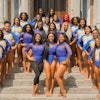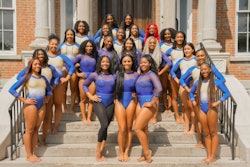Counterpoint: Slam Dunk is Not Life’s Ultimate Experience
During the recently completed National College Athletics Association men’s basketball tournament, how many times did you hear that rap about dreams of one sort or another coming true on that mystical, magical road to the Final Four? Whether the dream is of future upsets on Selection Sunday, an unlikely trip to the Sweet Sixteen, or a career in the National Basketball Association, the Final Four is about the selling of dreams.
Unfortunately, the dream that is being sold is really a nightmare.
A particularly vivid example of the dream-come-true spiel happened during the televised National Association of Basketball Coaches’ Slam-Dunk competition. Two bright-eyed, excited student athletes were being interviewed between slam-dunk attempts. Although their teams had long since been eliminated from the tournament, there they were anyway, hoopin’ at The Big Dance. And, true to form, the tone of the interview was about dreams, specifically, about how it doesn’t get any better than this.
What a nightmare!
The college athletic community — coaches, administrators, television executives, members of the media and fans — has sold the notion to college basketball players that life can not get any better than getting to the Final Four; that at the ripe old age of 20, they have reached the pinnacle of life experiences. We have led these youngsters, mostly Black, to believe that shooting or dunking the rock at the Final Four is a more meaningful and desirable life experience than earning a college degree and landing a challenging and rewarding job that will last a lifetime.
What we should be telling them is that college athletics is simply one chapter in building a productive and fulfilling life, not the final chapter.
One of the primary justifications for higher education’s tremendous investment in athletics is that it is our educational system’s best tool to promote racial integration and tolerance. Closely related to this belief is the very powerful notion that athletics opens various doors of opportunity for participants, particularly Blacks, to realize upward mobility through education.
With the majority of Division I basketball players being Black, it appears that college athletics is indeed a vehicle to achieve educational opportunity and future upward mobility. This claim, however, is a myth precisely because of the dream we sell. The sad fact is that Black student athletes buy into that dream much more readily, and we sell it to them much more readily because we expect less of them academically and socially. As a result, Division I football and basketball continues to be more about exploiting Black athletic talent to drive television ratings and advertising rates than it is about developing academic potential and the abilities and talents to ensure successful integration into the high-tech, information-based global economy of the future.
Selling a dream that implies lower academic and social expectations hardly results in future upward mobility. Simply consider the college athletic establishment itself. Minority advancement and opportunity has occurred almost exclusively on the fields of play. The number of Black athletic directors, conference commissioners and coaches remains abysmally low. It is ironic that college athletics is being sold in large part as being effective at promoting equality, opportunity and upward mobility in our society, yet meaningful “upward mobility” hasn’t even occurred within the college athletic establishment itself.
Of course, there will be those student-athletes who successfully reach the mountaintop that is the NBA. After all, that’s the goal isn’t it? And it is what we keep telling them. But we know the vast majority will not.
Yet, we continue to shamelessly promote the dream, not only to current student athletes, but also to millions of youngsters watching at home. We continue to cast college athletics as the educational vehicle through which young Blacks can build a better life for themselves. This, despite the fact that we know that college athletics is not about educational opportunity and social advancement, but simply athletic performance and million-dollar coaching contracts. We continue to sell the dream, regardless of the fact that for the vast majority, that dream will only lead to future nightmares.
Higher education is being looked upon to provide leadership in America’s struggle to meet the rapidly changing demands of the 21st Century. But, something is seriously wrong when the overriding message permeating the various activities associated with higher education’s most visible component not only promotes, but celebrates, the achievement of short-term, physical proficiency at the expense of long-term educational development. Clearly, something has to change. And the first step in initiating change must be to have open and critical dialogue regarding whether the marriage between high-visibility, mega-commercialized athletics and higher education continues to serve our best interests. In short, how can higher education provide the necessary leadership to address the challenges of the emerging Information Age when it is complicit in promoting the slam-dunk as life’s ultimate experience?
— John R. Gerdy is the author of the book The Successful College Athletic Program: The New Standard.
© Copyright 2005 by DiverseEducation.com



















